|
|
Post by SeaRat on Jun 19, 2017 19:16:01 GMT -8
That might be the only original duckbill left intact on earth. I have tried to get them out by soaking them in silicone spray for a week, but they never come out whole. Mine have all been very hard and delaminating. They look like layers of paper covered with black tar. I wonder what they were made of... I've read that they were dipped in latex, but don't know what the body was made out of. Phil, My duckbill, while intact, is not usable. It is cracked, and I don't want to risk the only intact original Healthways duckbill, so it's safely in my parts box. It has a crack in the neoprene down low, and any flexing opens that crack further, so I'm not going to risk it. I do have other ideas on the duckbill for the Healthways original SCUBA regulator. Take a look. 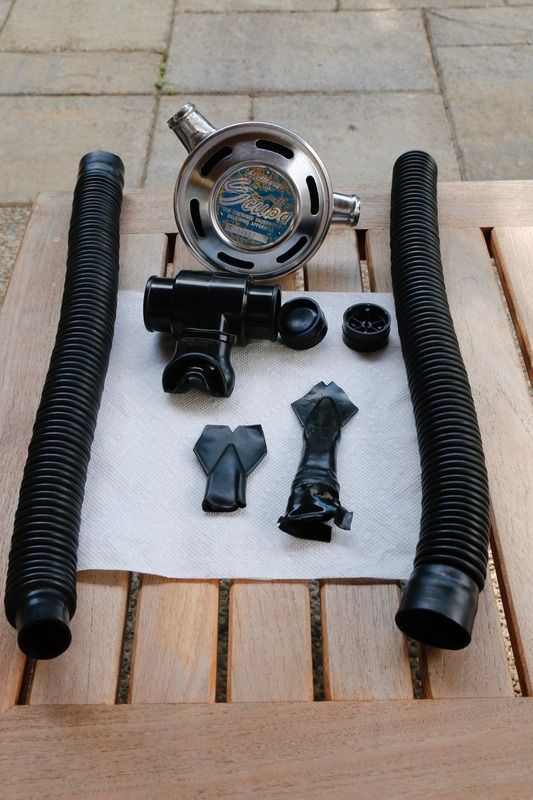 This shows the parts for my Healthways Hybrid SCUBA, with the Gold Label guts and the original box. I am taking the left-over USD duckbill, with the top, deteriorated part cut off, and cutting it down for my Healthways regulator. 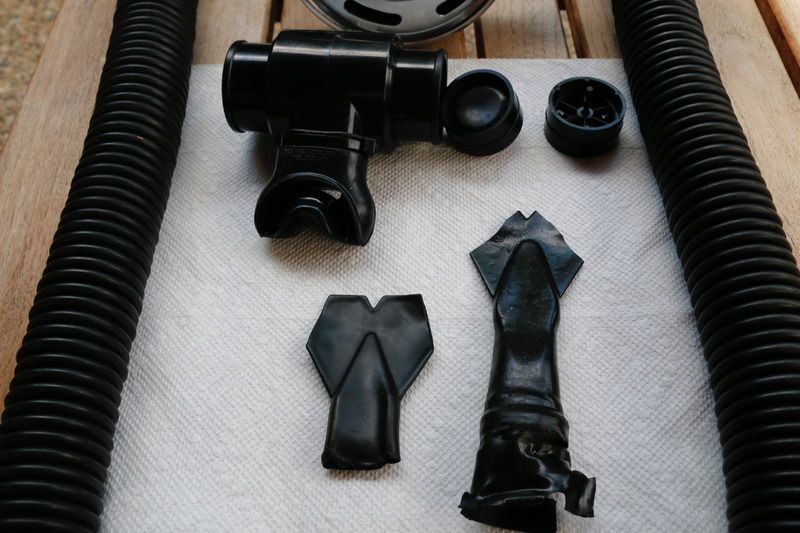 Here's a closer look, along with a look at the DSV mouthpiece that I'm putting on this Hybrid SCUBA regulator. I decided to give it the DSV mouthpiece because it has an internal diverter, which with the huge venturi of the GL Healthways can go to the exhaust. 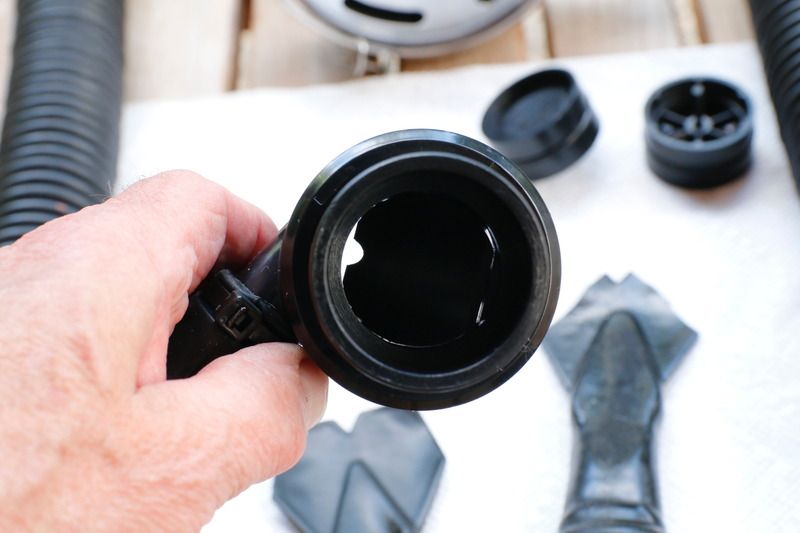 This shows the flow diverter inside the DSV mouthpiece. 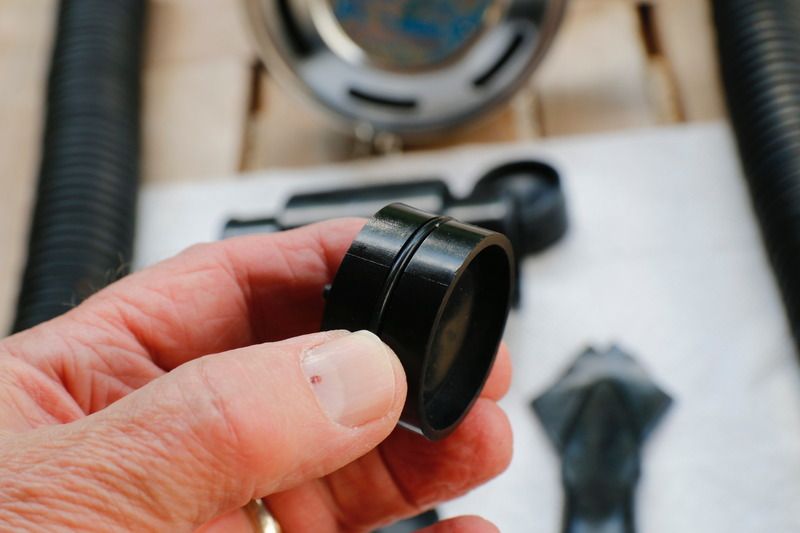 Note that the wagon wheels for the non-return valve has an O-ring on it. This is used to seal it into the mouthpiece, because the mouthpiece is made of hard plastic, and not soft neoprene or silicone. 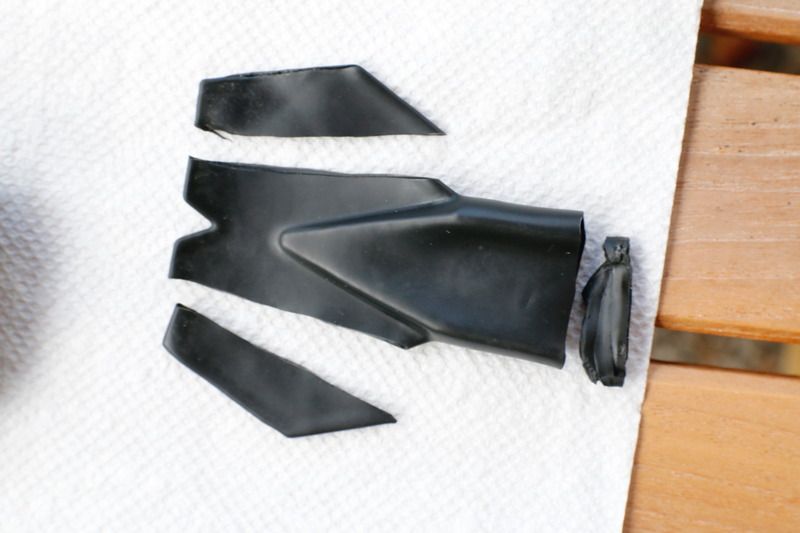 Here's the cutdown I made on the duckbill. Note that I left the bottom part attached, so that it will not fold up into itself, no matter what. 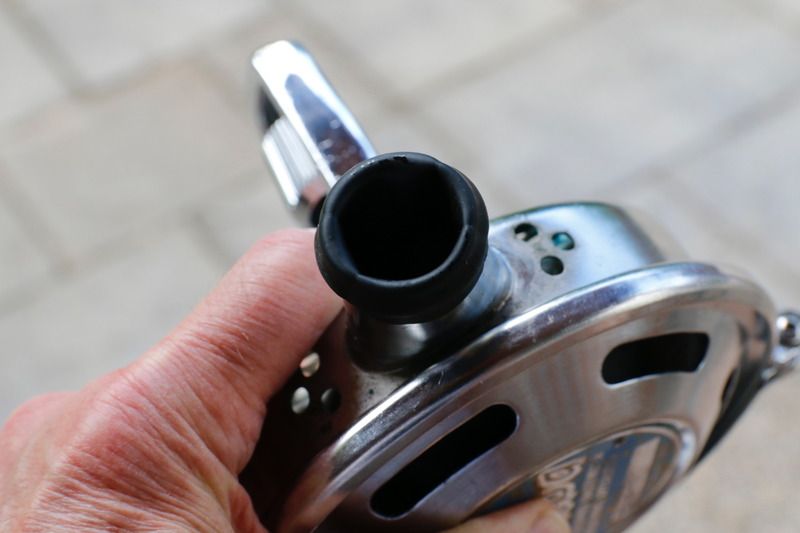 Here's the duckbill inserted into the exhaust chamber.  The Healthways Hybrid SCUBA fully assembled.  Note how low on the backpack this regulator can be mounted. 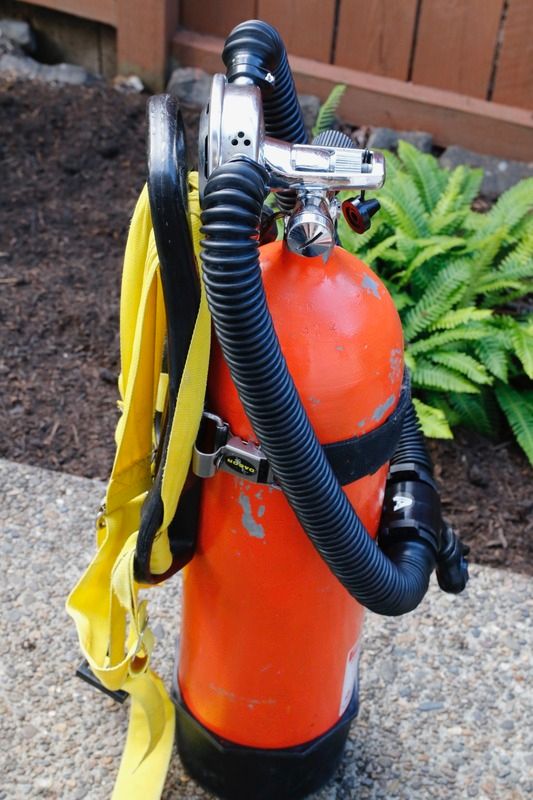 Here is a better view. I hope to put this regulator into the water tomorrow. More to report later. John |
|
|
|
Post by nikeajax on Jun 19, 2017 19:37:48 GMT -8
Looks like fun John: dang son, you'd be hard to miss with that yellow and orange; but I know, that's the point  JB |
|
|
|
Post by tomcatpc on Jun 19, 2017 20:44:28 GMT -8
Speaking of SCUBAs... I had some drama with mine last week. I was not getting nearly enough air and decided to abort a dive and swap out to another reg. Yes, I know that the original Healthways mouthpieces are deathtraps, but not this bad... I had this reg in open water a few times and it did fine.
Got it apart tonight and the set screw on the demand lever was loose. My mistake, so I played around and got it adjusted and it is a night and day difference. Going to try it out again this week.
Mark
|
|
|
|
Post by SeaRat on Jun 20, 2017 21:51:33 GMT -8
I am out of the water today, and I did dive my hybrid SCUBA regulator configured as above with the DSV mouthpiece. It worked pretty well, but at one point while I was observing the mating of lamprey eels (and videoing this, I might add) the regulator began leaking air through the exhaust. I found after a while that if I tipped my tanks down on the left side, that this leaking stopped. After getting back home, I took off the cover and found about a thimble full of water inside the regulator. I'm pretty sure that it came in through the exhaust diaphragm. I took that exhaust diaphragm off, and looked at the duckbill,but it was far enough up into the horn that it would not interfere with the exhaust diaphragm at all. Then I looked at the original exhaust diaphragm, and I'm pretty sure I know what happened. This diaphragm is supposed to block off the flow of air by the higher air pressure inside the box above the diaphrigm (in a vertical plane). This should give about a 1-1.5 inch pressure differential. If you'll remember your diving physics, in fresh water one atmosphere is about 34 feet of fresh water. 14.7/33.89 = 0.4349 psig per foot 0.4349 psig/ft /12 feet/inch = 0.0362 psig per inch 0.0362 x 1.5 = 0.0544 psig on the exhaust diaphragm; that's not very much pressure. Well, that diaphragm is very, very old, and not real flexible anymore. So it probably did not seal against the exhaust tube, which contributed to this leak. When I dipped my shoulder, I put more water pressure on the exhaust, and lessened the differential between the exhaust tube (with its air leak) and the main diaphragm. So now what I'm going to do is to replace this exhaust diaphragm with a more flexible one of the same nature as I have used in the past, made of very flexible but tough nitril from a clean room glove. Now, this regulator performed extremely well except for this small leak of air I mentioned above. It gave me all the air I needed under extremely trying current conditions, and allowed me to get very, very close to those lamprey eels while I was videoing them. 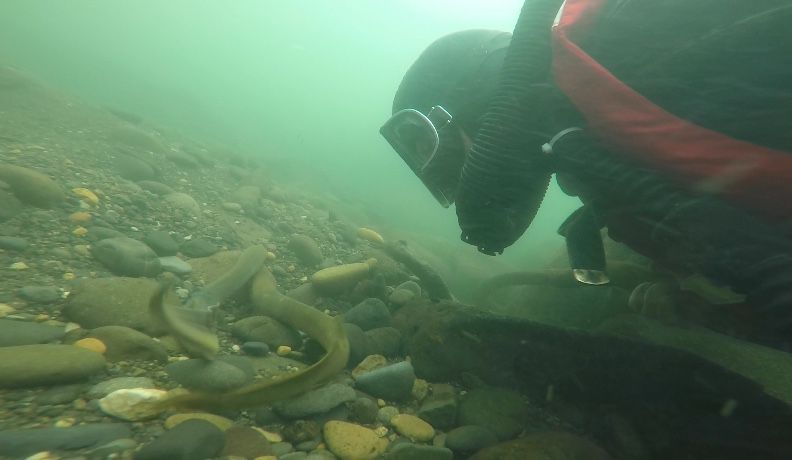 I also noted (again, as this isn't the first time) that with the openings on the original Healthways bottom box are large enough that the current does influence them, and that alone can initiate a small air leak. I am diving a brand new silicone diaphragm on this regulator (I got it on by simply going to the hardware store and getting a longer screw for the clamp ring), so it is a very sensitive diaphragm, and I had it set as easy as possible for breathing. John |
|
|
|
Post by tomcatpc on Jun 21, 2017 22:22:16 GMT -8
I put my SCUBA on an tank I just had dove down to 700-ish PSI. I took it for a short dive at the small "beach" entry at the local quarry. It performed much better (not as good as my Mistral which I had in the water just before) than it did last week! I took it down to just over 40' for a short time and no free flow. After about ten minutes I could feel the restrictor plate in the SCUBA start to take affect, I pulled my J-Valve Rod and the breathing returned to normal, just like it should. I surfaced and got out of the water to get my Scubair and another tank to spend another half hour under...a great dive and good to know the SCUBA is working again.
Mark
|
|
|
|
Post by vance on Jun 22, 2017 15:11:33 GMT -8
...... Well, that diaphragm is very, very old, and not real flexible anymore. So it probably did not seal against the exhaust tube, which contributed to this leak. When I dipped my shoulder, I put more water pressure on the exhaust, and lessened the differential between the exhaust tube (with its air leak) and the main diaphragm. So now what I'm going to do is to replace this exhaust diaphragm with a more flexible one of the same nature as I have used in the past, made of very flexible but tough nitril from a clean room glove. ...... John Hey, John, Thanks for the report on the Scuba! What kind of air leak do you mean? Was the regulator freeflowing? In any case, your exhaust diaphragm is leaking around the flange, if water got into the air side of the can. Nothing else on the exhaust side of the system could cause that. Of course, it could have gotten in on the intake side... I tried a silicone swim cap for an exhaust diaphragm, but found I couldn't get the clamp on and tight without cutting the material on the sharp edge of the flange. I've also used bike tube rubber, which seems to work better for me. I'm not sure the inner tube rubber is flexible enough to seal in all positions, but it worked fine in my pool test, with no freeflow. According to your explanation of the exhaust system on the Scuba, if the exhaust diaphragm doesn't seal, the regulator will freeflow, correct? |
|
|
|
Post by SeaRat on Jun 22, 2017 15:41:46 GMT -8
...... Well, that diaphragm is very, very old, and not real flexible anymore. So it probably did not seal against the exhaust tube, which contributed to this leak. When I dipped my shoulder, I put more water pressure on the exhaust, and lessened the differential between the exhaust tube (with its air leak) and the main diaphragm. So now what I'm going to do is to replace this exhaust diaphragm with a more flexible one of the same nature as I have used in the past, made of very flexible but tough nitril from a clean room glove. ...... John Hey, John, Thanks for the report on the Scuba! What kind of air leak do you mean? Was the regulator freeflowing? In any case, your exhaust diaphragm is leaking around the flange, if water got into the air side of the can. Nothing else on the exhaust side of the system could cause that. Of course, it could have gotten in on the intake side... I tried a silicone swim cap for an exhaust diaphragm, but found I couldn't get the clamp on and tight without cutting the material on the sharp edge of the flange. I've also used bike tube rubber, which seems to work better for me. I'm not sure the inner tube rubber is flexible enough to seal in all positions, but it worked fine in my pool test, with no freeflow. According to your explanation of the exhaust system on the Scuba, if the exhaust diaphragm doesn't seal, the regulator will freeflow, correct? Only in certain positions will it free-flow. The "leak" I was talking about is the leak of air through the exhaust system, due to an imperfect seal made by the exhaust diaphragm. As you know, this exhaust tube is not below the diaphragm, but above it, so if there is not a perfect seal it will flee-flow slightly. The water leak I had was incidental, as I don't use glue or anything on the exhaust diaphragm except the wire clamp to seal it. Yes, there is a bit, but that was not a problem during the dive. It would be a problem if I did not open the regulator up and dry it out between dives. I'm hoping to make a new exhaust diaphragm, perhaps starting tonight, for that regulator using the nitrile glove material. I'm going to first coat the clamp area of the exhaust with silicone grease, then put some Shoe-Goo semi-liquid onto the outside, then the glove material, then clamp it with the wire clamp. I'm going to repeat that one more time to make a double-diaphragm exhaust diaphragm that will actually easily seal off the exhaust tube. I've done that already (reported here in different threads) with a single diaphragm of glove material, but haven't tried the double yet. I feel more comfortable in open water with a double-diaphragm of the very flexible, but tough, glove material. John |
|
|
|
Post by vance on Jun 22, 2017 17:03:44 GMT -8
That's a lot of maintenance, if you open up the regulator after every dive! And you dive fresh water! I think a bit of rtv on the exhaust diaphragm to seal it is wise. I like the double diaphragm idea. There are some sources on line for silicone, EPDM, latex, and neoprene sheet material. I tried to order some, but got frustrated due to long shipping intervals. But, heavier, impervious rubber sheet might be the key.
So, in certain positions, when the exh diaphragm does not seal the horn, you get slight freeflow? Does this really matter in practice?
|
|
|
|
Post by SeaRat on Jun 22, 2017 17:43:08 GMT -8
No, it doesn't matter in practice, but I was diving my twin 42s (PJ tanks) and started with only about 2/3 of a fill, so I was really aware of my air consumption. I experimented with positions, and got the slight leak to stop. I was videoing lampreys spawning at the time in very heavy current, and the current could also have influenced the exhaust diaphragm. I'm in the middle of making the new exhaust diaphragm, and will be using the glove material. I got one glove from the clean room gloves I used at work, and a newer one from my doctor when she was examining me. Those exam gloves are also pretty tough, and made of the Nitril material. I don't want to buy sheet material, as most of it is too thick, and costs too much when I can get the material I want for free. Singe I only need about four square inches, the gloves will serve me well. Here's two photos of earlier experiments: 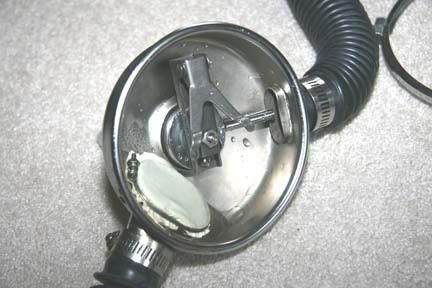 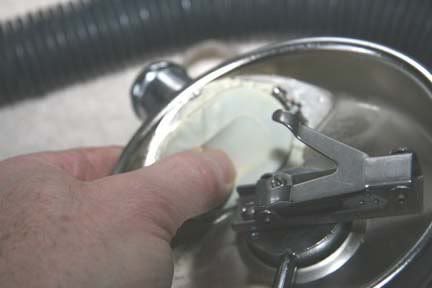 Note that I can seal the exhaust tube with my thumb, which I cannot do with the original Healthways exhaust diaphragm. I can also seal it by suction alone on the horn. That's how sensitive this diaphragm material is to the exhaust horn, and that's what I'm looking for. John PS, at 8:40 pm the second layer of the duel exhalation diaphragm is on. Now to let the Shoe-Goo dry overnight, and see if it works. |
|
|
|
Post by tomcatpc on Jun 23, 2017 19:50:09 GMT -8
I opened my SCUBA up tonight and there was a bit of water. I saw a very small hole where the screw of the wire clamp had wore against the rubber glove. So I cut a new exhaust diaphragm and put two layers on this time. I'll try and get it in the water in a week or so and see how it does.
Really wish this part could be reproduced someday...in the meantime guess our makeshift replacements will work?
Mark
|
|
|
|
Post by vance on Jun 27, 2017 9:59:54 GMT -8
I just got another Scuba which has a mostly intact and very pliable duckbill in it. I was successful in getting it out without destroying it. Unfortunately, the regulator had been stored without hoses, so the hose end of the DB got a bit beaten up. Sorry John! Yours is now one of two known examples (known by us!) of the working Scuba duckbill....
BTW, I just confirmed something: the screws that hold the Scuba lever assembly to the valve are exactly the same as the ones on a USD single stage.
These parts are available in the single stage service kit available from The Scuba Museum and VDH for about $12.
Of course, any stainless screws and nut that fit will work. It's also nice that these look exactly the same for authenticity's sake. As a bonus, the kit includes a snap ring for the HP valve that fits.
|
|
|
|
Post by vance on Jun 27, 2017 17:45:18 GMT -8
The Scuba I just got is quite remarkable in that the diaphragm, the exh diaphragm, the duckbill, and the other rubber parts are VERY pliable, flexible, and in excellent condition. My duckbill has some damage at the hose end, but the rest is very flexible and in great shape. The pinched end seals right up, and opens perfectly with exhalation pressure. A bit of RTV will fix it right up. But, like John said, can't risk it, and it goes in the baggie with silicone grease for posterity. This regulator looks new. I doubt it was used more than a couple of times. I bought it on eBay about a year ago, but it was only for local pickup. A friend who lives in the same town picked it up for me, but hasn't come to visit until this week. She brought it, and I was gobsmacked at its condition. This is the new keeper. I made a new duckbill for it yesterday and glued 'er in. Works perfectly!   
   
Even this one looks like it leaked water into the can. It shows you must glue the exhaust diaphragm in! Phil |
|
|
|
Post by vance on Jul 13, 2017 15:03:22 GMT -8
I just sold this one  to a guy in Indiana. He thinks it's awesome. It is. I has an excellent original exhaust diaphragm and main diaphragm, plus one of my duckbills. The label isn't so pretty, but it has that "done that" look. The rest of it is excellent, chrome and stainless parts are pristine. The hose loop is great too. The hoses have a bit of set, but they're intact.  
I think this brings the Scuba #s down to 5 + 1 that donated its guts to the Misuba rev1. I have another one on eBait, but nobody's going to buy it, due to the price I'm asking for it and the Hope Page mp it has on it. I think the Hope Page is worth more than the regulator. They're pretty scarce! |
|
|
|
Post by nikeajax on Jul 13, 2017 15:48:56 GMT -8
Phil, I totally agree: I don't think most people understand just how nice the HP is--very under rated!!! What are you asking for one of your duck bills: I need one, and I'll pay whatever you want  JB |
|
|
|
Post by nikeajax on Jul 13, 2017 16:16:17 GMT -8
So, Phil, what if you took some gun-bluing to the rings on that HW you have on eBait: that stuff turns just about anything black. I use it on my antique chandeliers to make the brass a really nice coffee color, but it may work on aluminum...
JB
|
|



























